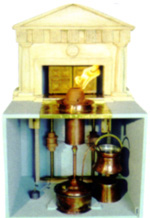Rome's most enduring legacy
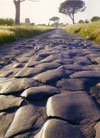
More than 50,000 miles of all-weather roads united an empire.
In
the 1st century AD Hero
of Alexandria ('On the dioptra') described
theodolites and the principles of surveying.
We've
Been Robbed!
"Were it not for
religious persecution and oppression of science, mankind might have
landed on the moon in the year 650.
Cancer may have been eradicated
forever by the year 800. And heart disease may, today, be unknown."
– David Mills (Science
Shams & Bible Bloopers, p362)
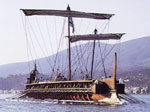
An Ancient Mechanic
Other
devices described in Hero's 'Automata and Balancings' include
a windmill-driven
pipe organ;
a steam boiler, later adapted
for the Roman baths;
the 'candelaria' – a self-trimming
lamp, in which the heat of candle-flames span a hoop from
which were suspended small figures;
and the 'Hydria' – a water-driven
clock.
|
Disastrously,
in the late 4th century, the fate of the Roman Empire fell
into the hands of Christian fanatic Theodosius and his progeny.
By the second half of the 5th century the simple division
of the empire had become a fragmentation, even of the very
language itself.
Bilingualism – of
Greek and Latin – which had characterised the early
empire, became increasingly rare. The Greek language – and
with it, an understanding of Hellenic culture, disappeared
entirely in the west, followed by a decline in the Latin
tongue, until only the clergy used it in a bastardised form. The
end of a common language signalled the abandonment of an international
cultural legacy which had created Roman civilization. With
geographic insularity came xenophobia, racism, and bizarre
beliefs about alien peoples in the now 'distant' lands. Life became parochial, simpler, impoverished and brutal.
Communication
by Land and Sea
|
BUILT BY PAGAN ROME
"The
Imperial Roman army could construct almost anything – roads,
bridges, tunnels, forts, walls, canals and even buildings for
purely peaceful use such as markets and bath-houses.
It had
its own potters,
its own blacksmiths, its own carpenters and its own masons – a
vast reserve of skilled labour, and in many of the Empire's
outer provinces the only supply of skilled labour available."
– N. Sitwell (Roman Roads
of Europe, p24)
The
earliest all-weather Roman road was the Via Appia, built in 312 BC.
By the end of the 3rd century BC a network of paved roads covered
Italy.
In 147 BC the first provincial road, Via Egnatia, was built
in Macedonia. By the close of the 3rd century AD, and the end of
Roman road building, 53,000 miles of road spanned the empire, from
Scotland to the Euphrates.
Typically a Roman road
was 16' to 20' wide and over a metre thick – twice that of
many modern roads!
More
than a means of moving troops, the road network made possible a
first-rate postal
system, the 'cursus publicus' established by
Augustus early in the 1st century .
Horses,
mules and oxen, stabled at post-houses, moved officials and government
freight, and also enabled scholars to exchanged
ideas
across
the empire.
|
|
RUINED BY CHRISTIANITY
With
the ruin of the Legions (replaced by mercenaries on horseback
and the imperial 'mobile field
army') road-making skills were lost and
the vast network of roads went unmaintained by the
Christian empire.
In
the 4th century, Christian
'theorists', taking advantage of official free travel, overwhelmed
the posts, justifying their endless excursions by the convening
of church councils:
"The highways
were covered with troops of bishops galloping from every
side to the assemblies, which they call synods; and while
they laboured to reduce the whole sect to their own particular
opinions, the public establishment of the posts was almost
ruined by their hasty and repeated journeys."
– Ammianus Marcellinus, Res Gestae
As
the decline continued,
unpaid post-house keepers deserted, and the roads,
beset by outlaws and slave-traders, were shunned rather than
used. Such travellers as there were learned to travel in groups
for mutual protection.
Christian
Europe built no new roads until the 18th century,
when France – like Rome 1500 years earlier – wanted
to move rapidly its standing army.
|
|
| |

|
The pagan Claudius Ptolemy's 2nd century map of the known world
speaks for itself. |
|
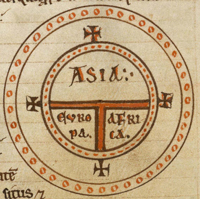
|
500 years after Ptolemy, Isodore, Bishop of Seville, came up with this beauty, a world map derived from scripture, not knowledge.
|
|
Traders
Roman
vessels travelled as far as east Africa and Sri Lanka, Syrian textiles
were traded in Boulogne, amber from the Baltic sold in Rome, furs
and silks from Asia could be bought in Constantinople.
The typical Roman merchant
ship had a length-to-breadth ratio of 2:1 and a capacity of around
500 tons. The larger grain ships had capacities of as much as 1300
tons.
A voyage from Ostia
to Alexandria took 3 weeks.

Navis oneraria
One Roman author proposed
a paddle boat, driven by oxen in a treadmill.
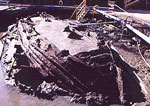
Wreck of early 2nd century
working boat (46' x 20'), Pisa. Capsized but in good
nick.
Caligula's
Giant Ship
1st century AD – and
the pagan Caligula builds a ship 95 metres (312') long and 21 metres (69') wide,
a 1300 ton monster.
It was recovered from
Lake Nemi in the 1920s/30s and then, sadly, completely destroyed
by fire during WWII.

Caligula's Behemoth in 1934
(that's a man circled).
A similar vessel
brought an obelisk from Egypt to stand in Caligula's circus (and subsequently, St Peter's Square!)
Navigation
With complex differential gearing the astronomical calculator found in a wreck off Antikythera is the most
sophisticated piece
of machinery yet found from the ancient world. The simpler astrolabe was widespread from the 2nd century BC.
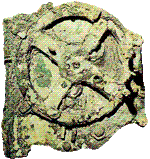
Antikythera "computer."
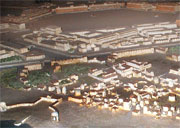
The new port built at Ostia by Emperor Claudius in the 1st century, using marine concrete.
|
|
Christian
sea-faring: desperately small craft and piracy affecting every sea
lane.
The Irish 'coracle' – in use from the 6th to the 20th century – was
a construction of basket work and skin.

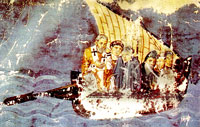
Minnows
In comparison to Caligula's giant barge,
1500 years later, Defender of the Faith Henry VIII, built
the pride of his fleet, the Mary Rose – a minnow of
32 metres and 700 tons.
Nelson's flagship
at Trafalgar in 1805 was only 69m and weighed in at 2162
tons.
Myopic raiders
Not until late in the 16th century could Christian Europe
assemble a navigational aid comparable to the astrolabe of the ancient world.
As a consequence, only
when Henry the Navigator explored the northwest coast
of Africa in the 15th century, did Christian Europeans again
venture
beyond the Mediterranean.
In contrast, the pagan Vikings had
established colonies as far as central Asia and North America
in
the 9th century, guided by their own simple navigational devices.
When
Europeans once again entered the Indian Ocean, after an absence
of 1200 years, it was aboard a Portuguese Man of War – and
a flourishing coastal civilization in east Africa was brutally
extinguished.
|
| |
|
| |
Industry
and Technology
|
In the 5th and
6th centuries, particularly after the arrival of the plague,
the Roman Empire no longer had
a limitless supply of slaves. It was precisely the circumstance
that would have
favoured an industrial revolution – but for the fact
the Empire had lurched into a theocratic tyranny.
|
| |

Ctesibius' Pump, from
Roman mine, Valverde Huelva, Spain
|
In the 2nd century BC Ctesibius's devised
a force pump.
On each side was a piston raised by a rocking handle,
which sucked water into a cylinder through a one-way valve. By pushing
the piston down, the water was forced into the outlet pipe.
The Romans adapted the
device to drain bilges, extinguish fires and feed fountains.
|

A
Christian View of Science ...
"There
is another form of temptation, even more fraught with danger. This
is the disease of curiosity...
It is this which drives us to try to discover the secrets
of nature, those secrets beyond our understanding,
which can avail us nothing and which
men should not wish to learn..."
- St. Augustine
|
|
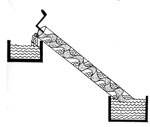
|
Archimedes was
one of the first scholars to apply theories of motion to mechanical
devices.
Among
the discoveries he described were the lever and – an extension
of the same principle – the "Archimedes screw," a
hand cranked device for lifting water.
Used
extensively throughout the ancient world.
|
The next step ...
The
screw could be adapted to push, rather than pull. It made possible
screw-driven ships – but that realisation came only in
the 18th century!
In
1838 the first purpose-built propeller-driven ship was called "Archimedes."
|
|
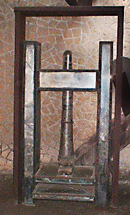
Cloth-press from Pompeii (79 AD) |
Printing?
How Close?
The Romans used the screw-press extensively on olives and grapes.
The printing press would
surely have followed – but for Christianity's
hostility to pagan knowledge.
When the printing press
saw the light of day in the 15th century the Catholic hierarchy opposed
its introduction, fearing copies of Scripture would fall into the
wrong hands and lead to criticism of 'God's Word.'
How right they were!
|

15th century: Gutenberg brings together existing technologies:
movable type, paper, oil-based ink and the screw-press familiar to the ancient Romans. Printing
is born.
|
|

4th Roman water-driven flour mill, Barbegal, France |
Mass
production:
Mill
Power
Undershot and overshot waterwheels were common
in the Roman world.
Power
to drive the millstones at Barbegal came from 16 waterwheels, arranged
in two parallel rows
of 8 on either side of the milling chambers. A spur from the local
aqueduct fed the mill with water.
The mill supplied the
port of Arelate (modern-day Arles) 12 km away with enough flour to
meet the daily flour needs of an estimated 80,000 people – about
10 tons per day.
There is also evidence
of Roman mass production of standardised
pottery, armaments and large-scale
mining.
|
Parochial
With
cities declining through neglect by the local elite and heavy
taxation, industry reverted to supplying a local trade.
Factories
deteriorated and were cannibalised but never repaired or replaced.
The
technology that gave rise to them was lost.
|
|

|
Christian
Science
“The
Byzantines invented clockwork, of a kind – and how did
they use it? To levitate the emperor in order to dazzle the
ambassadors
of barbarian Europe.”
– Hugh Trevor Roper (The Rise of Christian Europe, p24)
|
|

Roman emerald mine, Eastern Desert, Egypt |
Mining
A huge Roman iron factory, unearthed near Brayford, north
Devon, revealed furnaces, equipment and a massive dump of iron slag over
3 metres deep.
The factory would have been used to smelt hundreds of
tonnes of iron in the 2nd and 3rd centuries, most for export.
This industrial complex was greater than similar 19th century iron
working in the area.
Gold was mined widely: Dolaucothi, Wales; Rosia Montana, Romania; El
Bierzo, Spain.
|
Metallurgy lost
In
the world of Christendom, mines were abandoned, and metal production
dropped.
Reliable
coinage, especially
gold, grew scarce, and people found themselves in a nearly
'money less' economy, bartering goods or paying with their labours.
"It is a rather
astonishing fact that from the days of classical antiquity to
the end of the 19th century only one new metal came into general
use. This exception was aluminium, but even in 1900 world production
was no more than 10,000 tonnes."
– T. Williams (The Triumph of Invention, p181)
|
|
Only in the 15th
century, with the development of crystal glass on the island
of Murano (Venice) was the quality of Roman glassware again approached.
|
|

Wall painting of fruit
in glass bowl – 1st century Oplontis
near Pompeii |
Glass
Manufacture
About 1st century BC glass-blowing began to replace glass casting
in Syria.
Roman versatility with
glass has never been equalled.
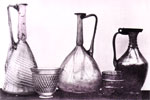
Roman
glassware
|
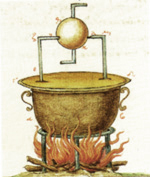
Turbine, 1st century AD. (Alexandria)
|
The Steam Turbine?
Hero's
'Pneumatica,' a two-volume work, detailed many machines worked
by air, steam or water pressure.
"The aeolipile
was a hollow sphere mounted so that it could turn on a pair of
hollow tubes that provided steam to the sphere from a cauldron.
The steam escaped from the sphere from one or more bent tubes projecting
from its equator, causing the sphere to revolve. The aeolipile is the
first known device to transform steam into rotary motion."
– Hero, The Pneumatica
Without
the dead hand of Christianity strangling scientific development a
low-pressure beam
engine might easily have been developed.
|
The next step ...
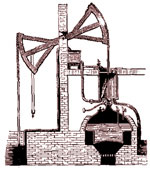
The Beam engine.
Driven by a low-pressure boiler the rocking beam began the
industrial revolution – but not until the
18th century.
|
|
|
Hero
of Alexandria also invented or described a variety of devices which
appear at first glance to have been whimsical – such as 'robot statues' that
mixed and poured drinks or 'sang' (via compressed air).
They
almost certainly were used by Hero to teach scientific principles.
|
|
| |
|
|

Fordicus? |
Road
Vehicles?
In 19th century Europe, powered road vehicles were
held back by lack of roads (and hence the railways developed first).
Ironically,
the
Roman
world
had developed a fine network of roads.
But for the disaster of Christianity, we might have had a 5th
century Henry Ford!
|
Cugnot's steam-wagon
(1769) – within the skills of Roman
engineers.
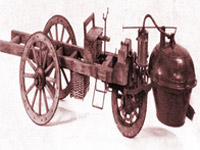
|
|
|
|
 Lost
World – Civilization Erased
by Piety and Fanaticism (Part
One) Lost
World – Civilization Erased
by Piety and Fanaticism (Part
One)
Sources:
K.D. White, Greek & Roman Technology (Thames & Hudson,
1984)
Trevor Williams, The Triumph of Invention (Macdonald Orbis, 1987)
Thomas Crump, A Brief History of Science (Robinson, 2001)
John Gribbin, Science, A History (Penguin, 2003)
Lisa Rosner(Ed.), Chronology of Science (Helicon, 1999)
F. G. Bratton, A History of the Bible (Robert Hale 1961)
Thomas Cahill, How the Irish Saved Civilization (Doubleday, 1995)
N. Sitwell, Roman Roads of Europe (Cassell, 1981)
Frank Delaney, A Walk in the Dark Ages (Fontana, 1988)
Henri Pirenne, Medieval Cities (Princeton, 1952)
| |
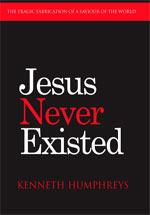
|
 |

|

|
Some fifty articles are now available as a book.
For your copy order:

|
|
Copyright © 2004 by Kenneth
Humphreys.
Copying is freely permitted, provided credit is given to the author and no
material herein is sold for profit. |
|

Lost World – Civilization Erased by Piety and Fanaticism (Part One)





















